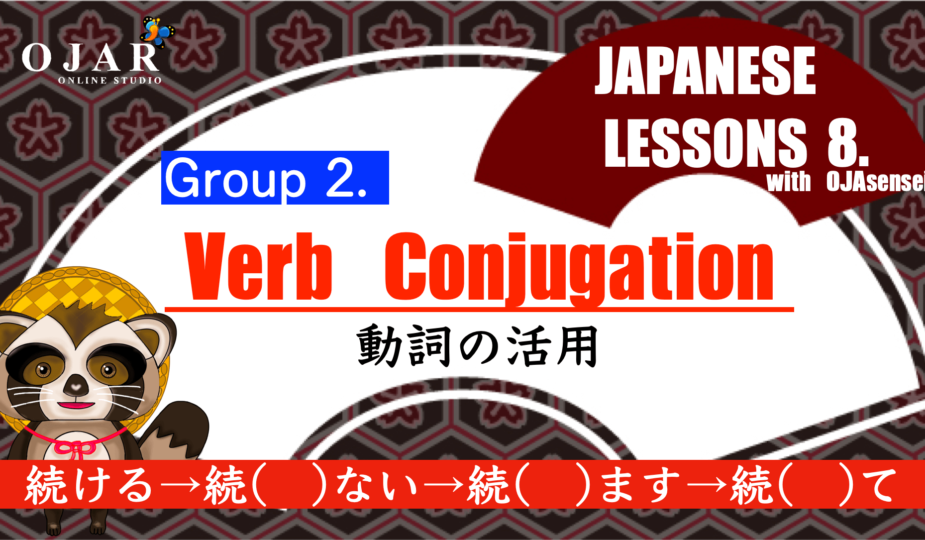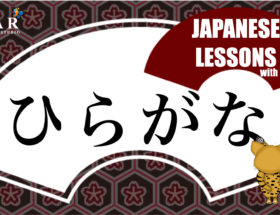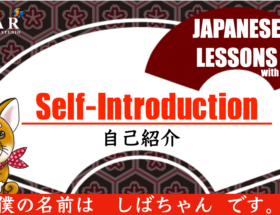Hi, my students 😄 Let’s learn verb conjugation this time too! Group 2 verb conjugation is “上一段活用 kami-ichidan-katsuyou” and “下一段活用 shimo-ichidan-katsuyou”. I’m going to teach you the way of grammar which Japanese kids learn.
*I can’t perfectly apply the way because Japanese learners who don’t speak Japanese as mother tongue don’t have potential knowledge for Japanese.
A Dictionary of Basic Japanese Grammar
| Amazon Reviews: | ★★★★★ |
|---|
Publisher: JAPAN TIMES
CONTENTS
■What is Group 2 Verb?
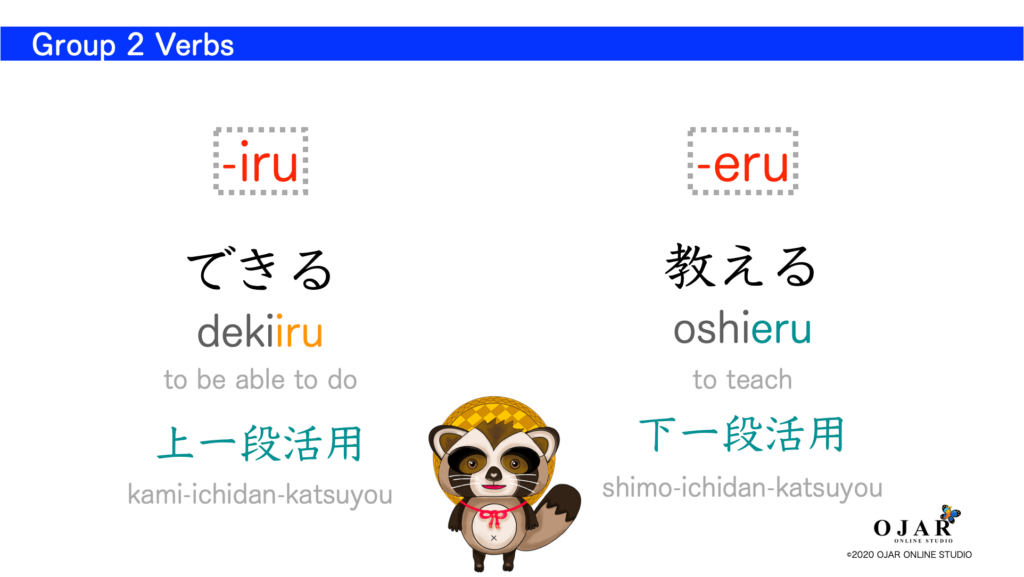
Group 2 verb is the verbs which conjugate with only “-i sound” or “-e sound”. Japanese kids learn it in the age of 14 year-old as 上一段活用 and 下一段活用 in national language class. Identifying 上一段活用, 下一段活用 and 五段活用 is difficult even Japanese people. We have to classify the verbs properly when we conjugate the verbs in advance.
I have already gave the detail lesson in this article “How to Classify Verbs”.
■ Learn Conjugation Forms
| 辞書形 jisho-form |
|---|
| “辞書形 jisho -form” appears in a dictionary. It’s like a “ to do” in English. It always becomes -iる in 上一段活用 and -eる in 下一段活用. When you learn verbs you need to learn this form the first definitely. |
| ない形 nai-form |
|---|
| “ない形 nai-form” conjugates to negative-form. It’s like a “not to do” in English. It always becomes -i sound in 上一段活用 and -e sound in 下一段活用. Japanese learners need to learn this form definitely. |
| ます形 masu-form |
|---|
| “ます形 masu-form” conjugates to polite-form. There is no expression in English. It always becomes -i sound in 上一段活用 and -e sound in 下一段活用. Japanese learners need to learn this form definitely. |
| て形 te-form |
|---|
| “て形 te-form” is used when the verb follows other adjectives or verbs. It corresponds to the grammar of English “An Infinitive” or “A gerund”. It always becomes -i sound in 上一段活用 and -e sound in 下一段活用. |
■ How to conjugate ichidan-Verb
“上一段活用 kami-ichidan-katsuyou” and “下一段活用 shimo-ichidan-katsuyou” are the way of verb conjugation of Group 2. The big difference between classifying verbs and Verb conjugation is; we focus on the sound before the suffix when we classify verbs and we focus on the suffix itself when we conjugate verbs.
| Form | English | Meaning | Following- conjugation | sound |
|---|---|---|---|---|
| 語幹 gokan | stem | the part of a word taken off the ending | – | – |
| 未然形 mizen-kei | nai-form | the form for the thing’s happened not yet | ない よう | -i / -e |
| 連用形 renyou-kei | masu-form / te-form | the form follows an adjective or a verb | ます た て | -i / -e |
| 終止形 shuushi-kei | jisho-form | the form ends with “。” | 。 | -iru/ –eru |
| 連体形 rentai-kei | – | the form follows a noun | とき こと | -iru / -eru |
| 仮定形 katei-kei | – | the form for supposition | ば | -ire / -ere |
| 命令形 meirei-kei | imperative form | the form for imperative form | 命令 | -iro iyo / -ero -eyo |
■ Following Other Words
| よう you |
|---|
| “よう you” are auxiliaries to make suggestions or offers. it’s same as “let’s” in English. It always becomes -i sound in 上一段活用 and -e sound in 下一段活用. |
| e.g. 日本語を 覚えよう。 Let’s memorize Japanese. |
| た ta |
|---|
| “た ta” are auxiliaries to make the past tense or the perfect tense. It’s same as “-ed” in English. It always becomes -i sound in 上一段活用 and -e sound in 下一段活用. |
| e.g. 日本語を 覚えた。 I learned Japanese. |
| 終止形 shuushi-kei a conclusive form |
|---|
| “終止形 shuushi-kei a conclusive form” is “jisho-form a dictionary form”. It usually ends with “。読点 touten ,” . period” in English. You can use it when you assert or itemize something. It always becomes -iる in 上一段活用 and -eる in 下一段活用. |
| e.g. 本で 日本語を 覚える。 I memorize Japanese words with books. |
| とき toki |
|---|
| “とき toki” is a noun to make a sentence of the flow the time. It’s a same meaning of “when” as a conjunction in English. It always becomes -iる in 上一段活用 and -eる in 下一段活用. |
| e.g.家に いたとき、 友達が 訪ねてきました。 My friends visited me when I was at home. |
| こと koto |
|---|
| “こと koto” is a noun when you use a verb as a noun. It corresponds to the grammar of English “A gerund” of “-ing”. It always becomes -iる in 上一段活用 and -eる in 下一段活用. |
| e.g. 漢字を 覚えることは、難しいです。 Memorizing Kanji is difficult. |
| ば ba |
|---|
| “ば ba” is a particle to make a sentence of introducing possible or impossible situations. It’s a same meaning of “if” as a conjunction in English. It always becomes -iれ in 上一段活用 and -eれ in 下一段活用. |
| e.g. 日本語を 覚えれば、楽しく 友達と 話せます。 You can enjoy talking with friends if you learn Japanese. |
| 命令形 meirei-kei imperative form |
|---|
| “命令形 meirei-kei imperative form” is used when you say “Do something.” or requests. It always becomes -iろ or -iよ in 上一段活用 and -eる or -eよ in 下一段活用. |
| e.g. 静かに 寝ろ! Keep your voice down and sleep now! |
■ Classifying Ichidan-Katsuyou
The name of “一段活用 ichidan-katsuyou” is different depending on the conjugation of “行 gyou row” of Hiragana. The way of identifying the name is the initial of the suffix.
For example:
・ いる iru conjugates with i so it’s “ア行上一段活用 Agyou-kami-ichidan-katsuyou”.
・得る eru conjugates with e so it’s “ア行下一段活用 Agyou-shimo-ichidan-katsuyou”.
・ 寝る neru conjugates with ne so it’s “ナ行下一段活用 NAgyou-shimo-ichidan-katsuyou”.
Read this if you want to know about rows and columns of Hiragana.
■ 上一段活用 kami-ichidan-katsuyou
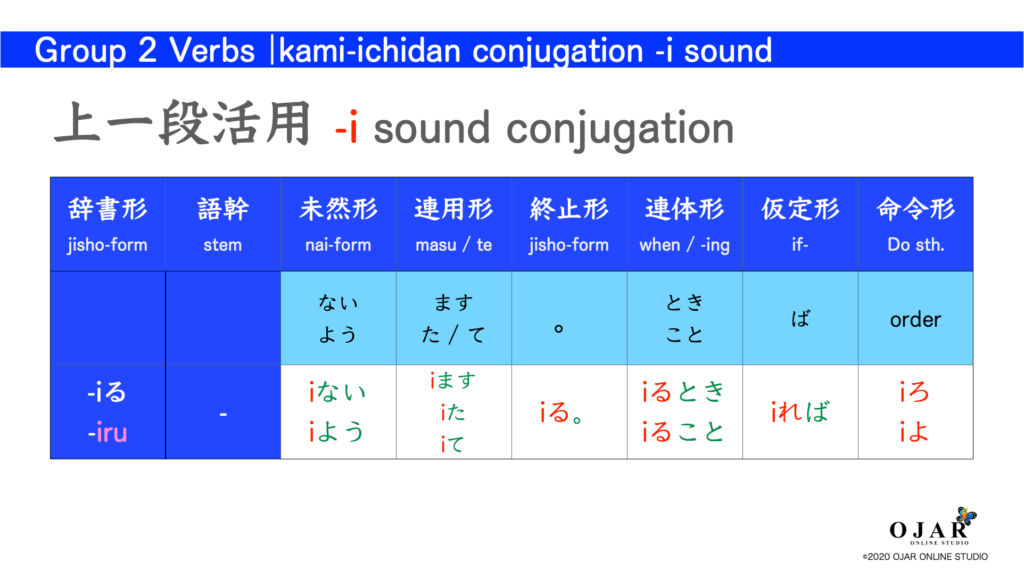
Kami-ichidan-katsuyou only conjugate -i sound. There are several verbs in which there is no difference between a suffix and a stem.
・ア行上一段活用 i conjugation
“ア行上一段活用 Agyou-kami-ichidan-katsuyou” always conjugates with i of the suffix.
Let’s think about “いる iru to exist”. This verb doesn’t have the difference between the stem and the suffix.
語幹:いる
活用語尾:いる
活用:ア行上一段活用 Agyou-kami-ichidan-katsuyou
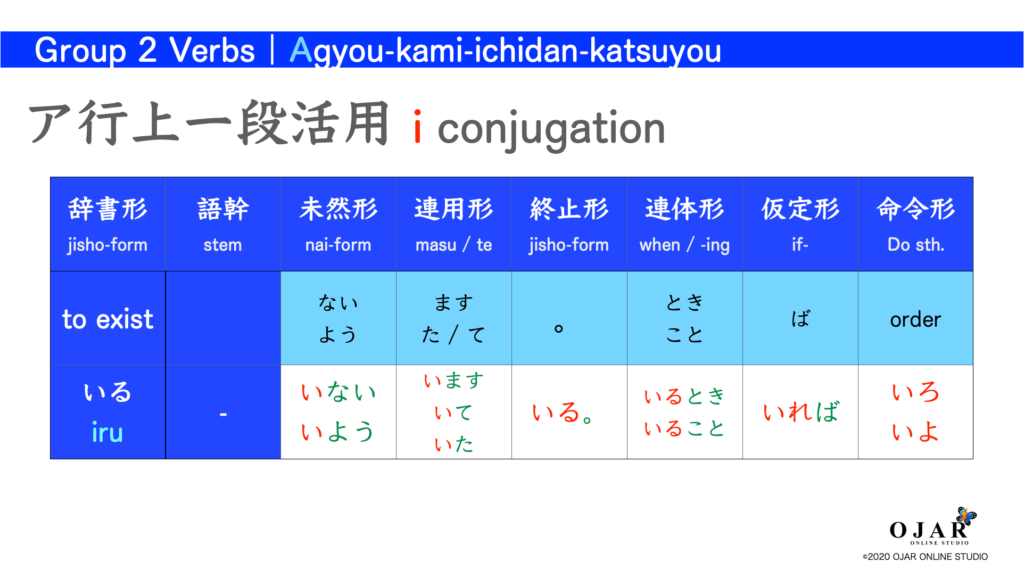
There are other verbs like this below.
| 辞書形 jisho-form | 未然形 nai-form | 連用形 masu-form / te-form | 終止形 jisho-form | 連体形 rentai-kei | 仮定形 katei-kei | 命令形 order-form |
|---|---|---|---|---|---|---|
| 用いる mochiiru to use | 用いない 用いよう | 用います 用いた 用いて | 用いる。 | 用いるとき 用いること | 用いれば | 用いろ 用いよ |
| 強いる shiiru to force | 強いない 強いよう | 強います 強いた 強いて | 強いる。 | 強いるとき 強いること | 強いれば | 強いろ 強いよ |
| 率いる hikiiru to lead | 率いない 率いよう | 率います 率いた 率いて | 率いる。 | 率いるとき 率いること | 率いれば | 率いろ 率いよ |
・カ行上一段活用 ki conjugation
“カ行上一段活用 KAgyou-kami-ichidan-katsuyou” always conjugates with ki of the suffix. Let’s think about “起きる okiru to get up”.
語幹:起
活用語尾:きる
活用: カ行上一段活用 KAgyou-kami-ichidan-katsuyou
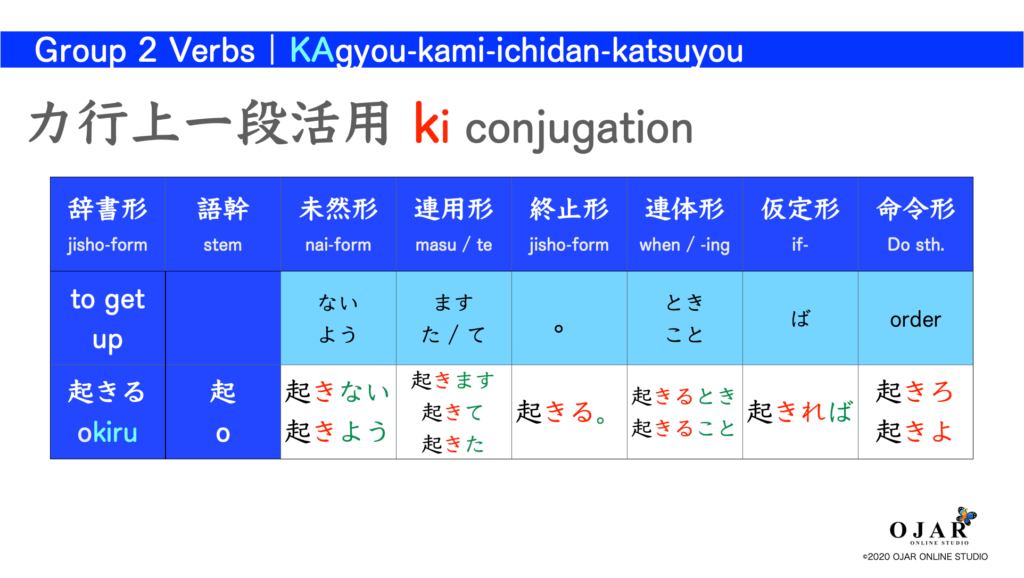
There are other verbs like this below.
| 辞書形 jisho-form | 未然形 nai-form | 連用形 masu-form / te-form | 終止形 jisho-form | 連体形 rentai-kei | 仮定形 katei-kei | 命令形 order-form |
|---|---|---|---|---|---|---|
| 着る kiru to get dress | 着ない 着よう | 着ます 着た 着て | 着る。 | 着るとき 着ること | 着れば | 着ろ 着よ |
| 飽きる akiru to be bored | 飽きない 飽きよう | 飽きます 飽きた 飽きて | 飽きる。 | 飽きるとき 飽きること | 飽きれば | 飽きろ 飽きよ |
| できる dekiru to be able to do | できない できよう | できます できた できて | できる。 | できるとき できること | できれば | できろ できよ |
・ガ行上一段活用 gi conjugation
“ガ行上一段活用 GAgyou-kami-ichidan-katsuyou” always conjugates with gi of the suffix. Let’s think about “過ぎる sugiru to pass”.
語幹:過
活用語尾:ぎる
活用: ガ行上一段活用 GAgyou-kami-ichidan-katsuyou
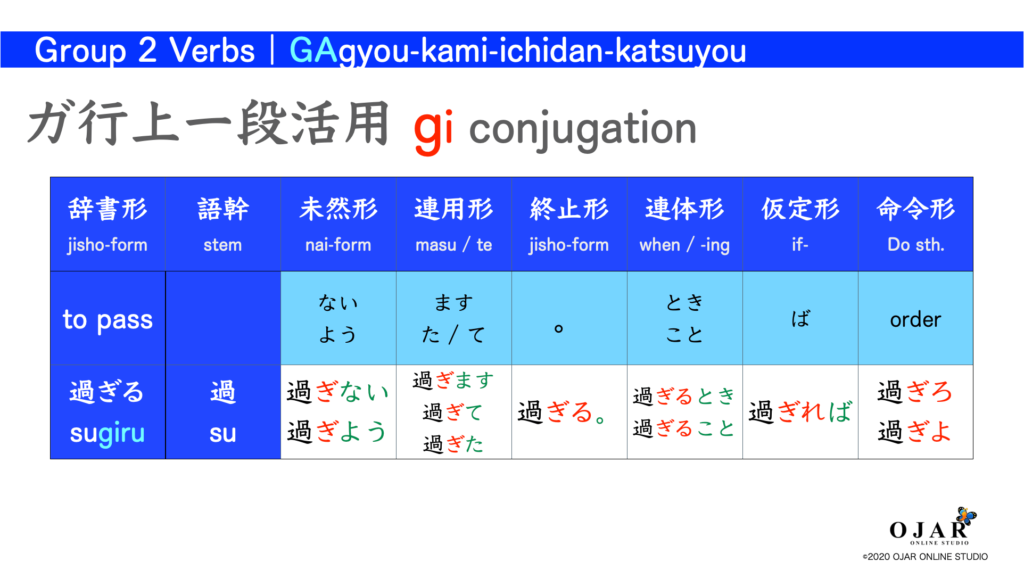
There are only “過ぎる” or compounded verbs in this conjugation.
・ナ行上一段活用 ni conjugation
“ナ行上一段活用 NAgyou-kami-ichidan-katsuyou” always conjugates with ni of the suffix. Let’s think about “煮る niru to boil”.
語幹:煮る
活用語尾:煮る
活用: ナ行上一段活用 NAgyou-kami-ichidan-katsuyou
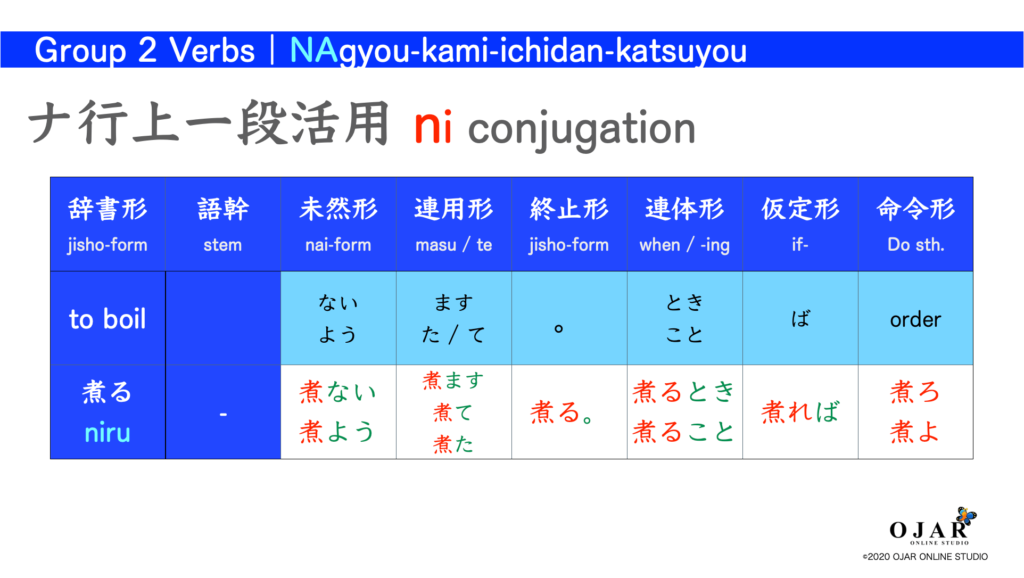
There are an only few verbs which we don’t usually use in this conjugation.
・マ行上一段活用 mi conjugation
“マ行上一段活用 MAgyou-kami-ichidan-katsuyou” always conjugates with mi of the suffix. Let’s think about “見る miru to see”.
語幹:見る
活用語尾:見る
活用: マ行上一段活用 MAgyou-kami-ichidan-katsuyou
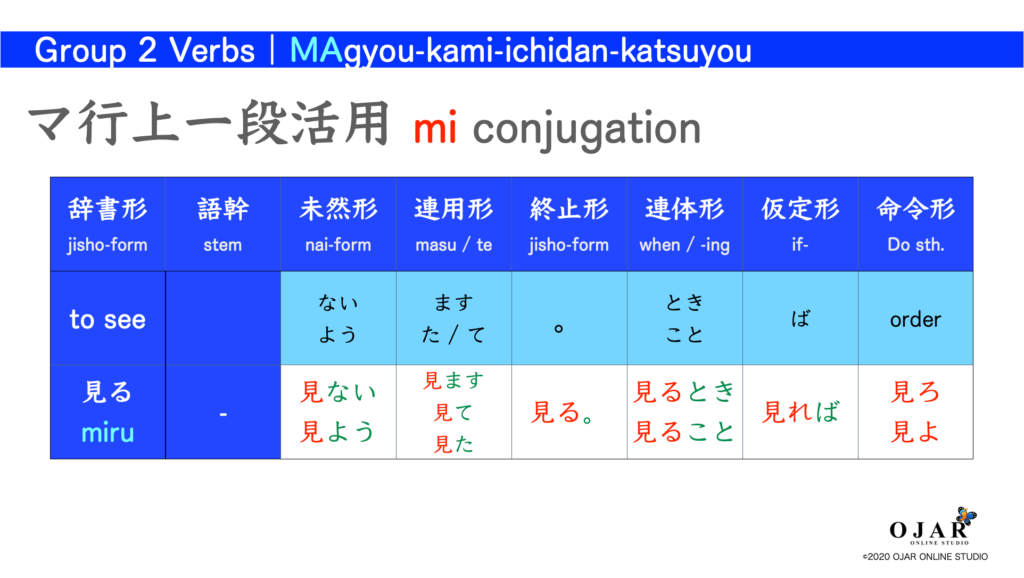
There are other verbs like this below.
| 辞書形 jisho-form | 未然形 nai-form | 連用形 masu-form / te-form | 終止形 jisho-form | 連体形 rentai-kei | 仮定形 katei-kei | 命令形 order-form |
|---|---|---|---|---|---|---|
| 試みる kokoromiru to try | 試みない 試みよう | 試みます 試みた 試みて | 試みる。 | 試みるとき 試みること | 試みれば | 試みろ 試みよ |
■ 下一段活用 shimo-ichidan-katsuyou
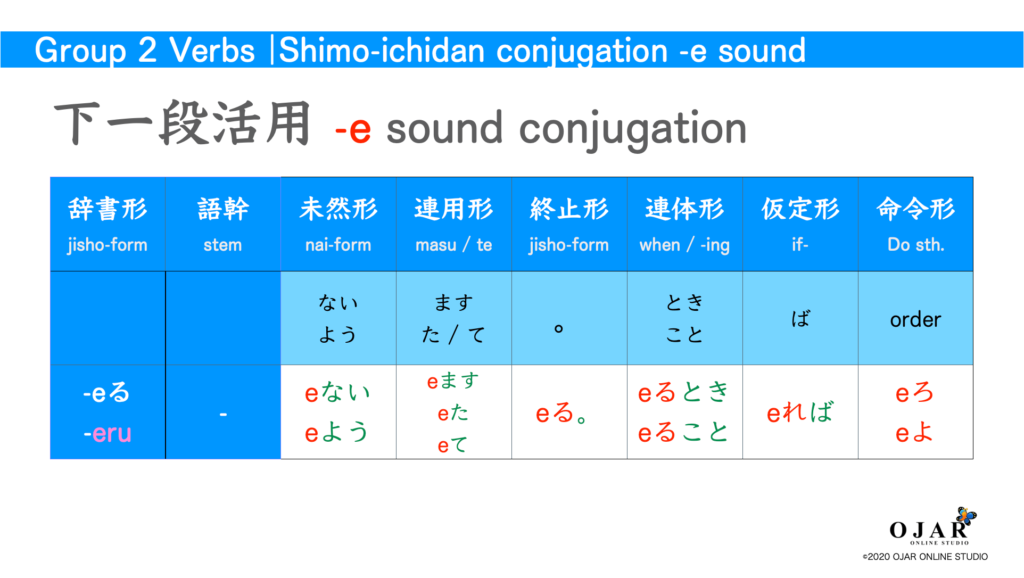
Shimo-ichidan-katsuyou only conjugate -e sound. There are several verbs in which there is no difference between a suffix and a stem.
・ア行下一段活用 e conjugation
“ア行下一段活用 Agyou-shimo-ichidan-katsuyou” always conjugates with e of the suffix. Let’s think about “答える kotaeru to answer”.
語幹:答
活用語尾:える
活用:ア行下一段活用 Agyou-shimo-ichidan-katsuyou
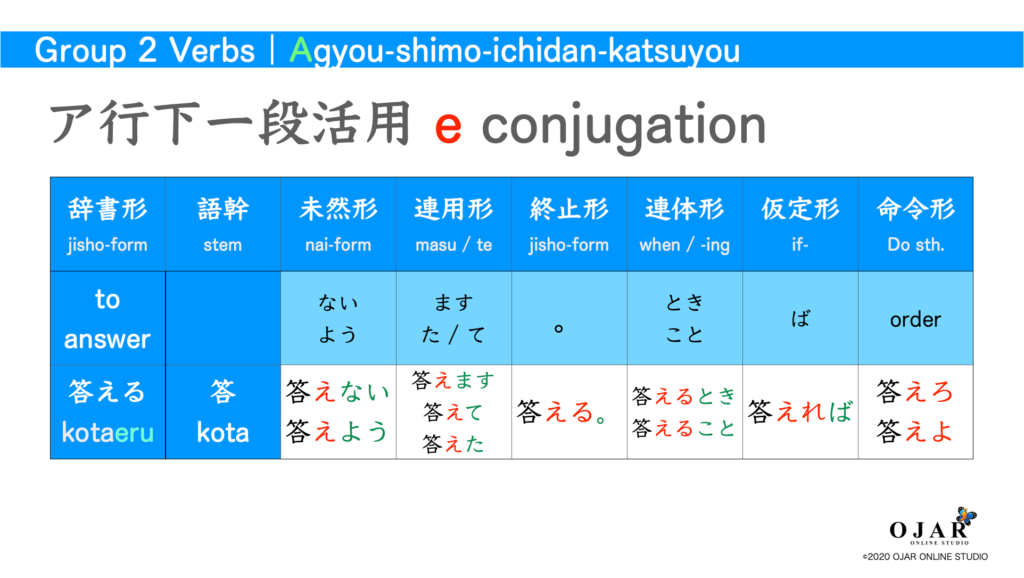
There are other verbs like this below.
| 辞書形 jisho-form | 未然形 nai-form | 連用形 masu-form / te-form | 終止形 jisho-form | 連体形 rentai-kei | 仮定形 katei-kei | 命令形 order-form |
|---|---|---|---|---|---|---|
| 教える oshieru to teach | 教えない 教えよう | 教えます 教えた 教えて | 教える。 | 教えるとき 教えること | 教えれば | 教えろ 教えよ |
| 消える kieru to disappear | 消えない 消えよう | 消えます 消えた 消えて | 消える。 | 消えるとき 消えること | 消えれば | 消えろ 消えよ |
| 燃える moeru to burn | 燃えない 燃えよう | 燃えます 燃えた 燃えて | 燃える。 | 燃えるとき 燃えること | 燃えれば | 燃えろ 燃えよ |
・カ行下一段活用 ke conjugation
“カ行下一段活用 KAgyou-shimo-ichidan-katsuyou” always conjugates with ke of the suffix. Let’s think about “付ける tsukeru to put”.
語幹:付
活用語尾:ける
活用:カ行下一段活用 KAgyou-shimo-ichidan-katsuyou
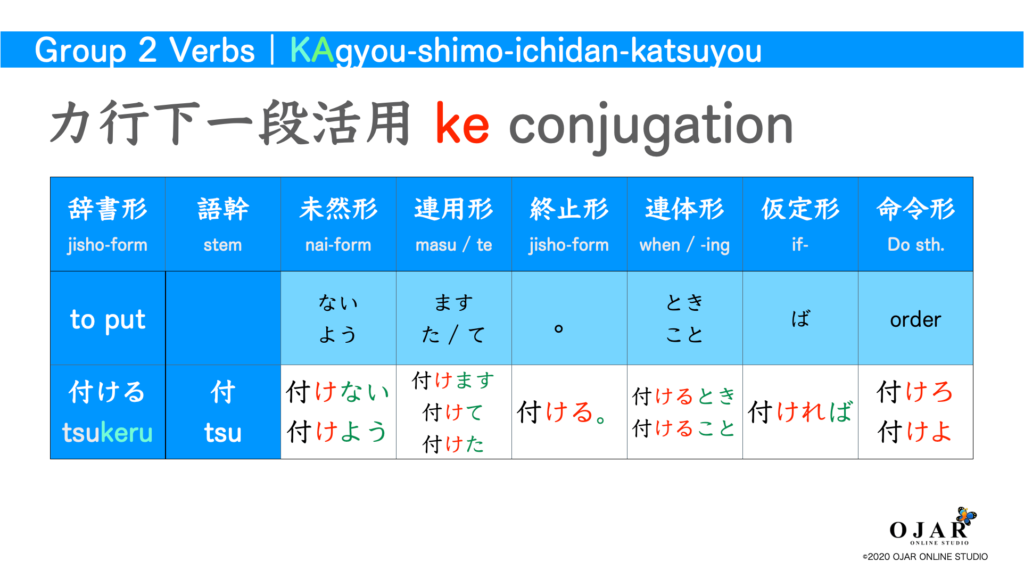
There are other verbs like this below.
| 辞書形 jisho-form | 未然形 nai-form | 連用形 masu-form / te-form | 終止形 jisho-form | 連体形 rentai-kei | 仮定形 katei-kei | 命令形 order-form |
|---|---|---|---|---|---|---|
| 受ける ukeru to take | 受けない 受けよう | 受けます 受けた 受けて | 受ける。 | 受けるとき 受けること | 受ければ | 受けろ 受けよ |
| 掛ける kakeru to hang | 掛けない 掛けよう | 掛けます 掛けた 掛けて | 掛ける。 | 掛けるとき 掛けること | 掛ければ | 掛けろ 掛けよ |
| 分ける wakeru to divide | 分けない分けよう | 分けます 分けた 分けて | 分ける。 | 分けるとき 分けること | 分ければ | 分けろ 分けよ |
・サ行下一段活用 se conjugation
“カ行下一段活用 SAgyou-shimo-ichidan-katsuyou” always conjugates with se of the suffix. Let’s think about “合わせる awaseru to fit”.
語幹:合わ
活用語尾:せる
活用:サ行下一段活用 SAgyou-shimo-ichidan-katsuyou
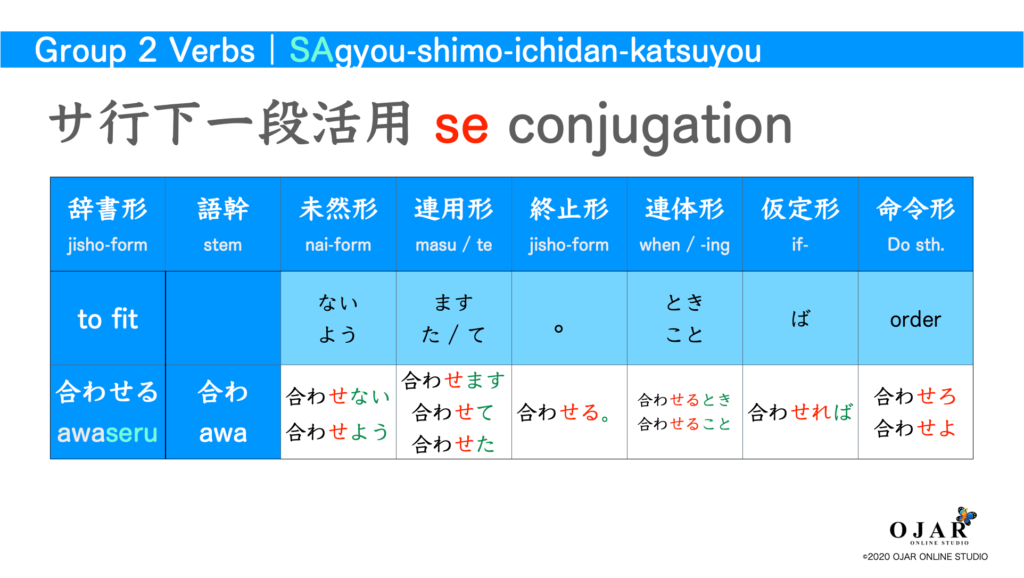
There are other verbs like this below.
| 辞書形 jisho-form | 未然形 nai-form | 連用形 masu-form / te-form | 終止形 jisho-form | 連体形 rentai-kei | 仮定形 katei-kei | 命令形 order-form |
|---|---|---|---|---|---|---|
| 寄せる yoseru to pull up | 寄せない 寄せよう | 寄せます 寄せた 寄せて | 寄せる。 | 寄せるとき 寄せること | 寄せれば | 寄せろ 寄せよ |
| 任せる makaseru to entrust | 任せない 任せよう | 任せます 任せた 任せて | 任せる。 | 任せるとき 任せること | 任せれば | 任せろ 任せよ |
| 問い合わせる toiawaseru to inquire | 問い合わせない 問い合わせよう | 問い合わせます 問い合わせた 問い合わせて | 問い合わせる。 | 問い合わせるとき 問い合わせること | 問い合わせれば | 問い合わせろ 問い合わせよ |
・ザ行下一段活用 ze conjugation
“ザ行下一段活用 ZAgyou-shimo-ichidan-katsuyou” always conjugates with ze of the suffix. Let’s think about “混ぜる mazeru to mix”.
語幹:混
活用語尾:ぜる
活用:ザ行下一段活用 ZAgyou-shimo-ichidan-katsuyou
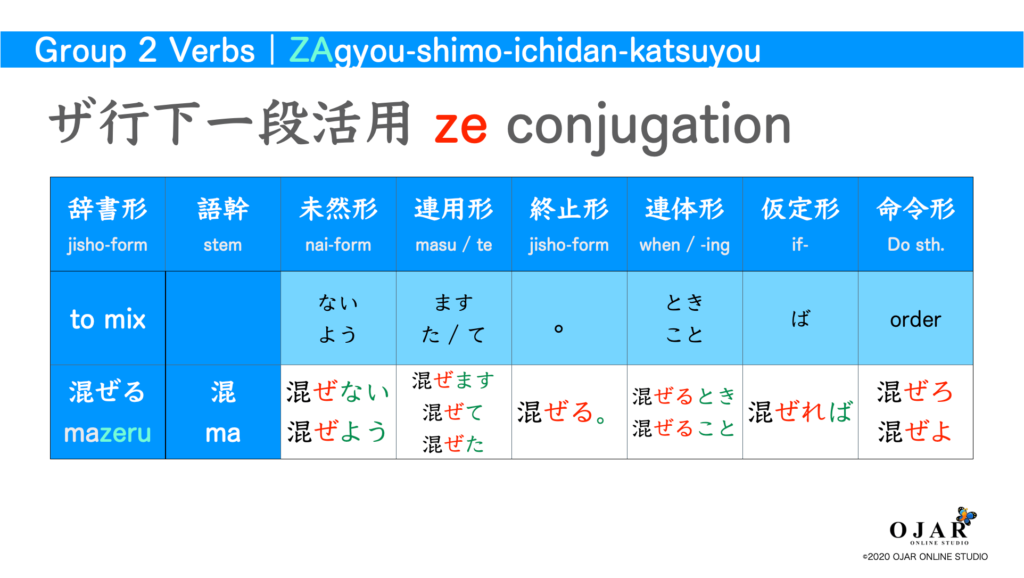
There are an only few verbs which we don’t usually use in this conjugation.
・ダ行下一段活用 de conjugation
“ダ行下一段活用 DAgyou-shimo-ichidan-katsuyou” always conjugates with de of the suffix. Let’s think about “出る deru to leave”.
語幹:出る
活用語尾:出る
活用:ダ行下一段活用 DAgyou-shimo-ichidan-katsuyou
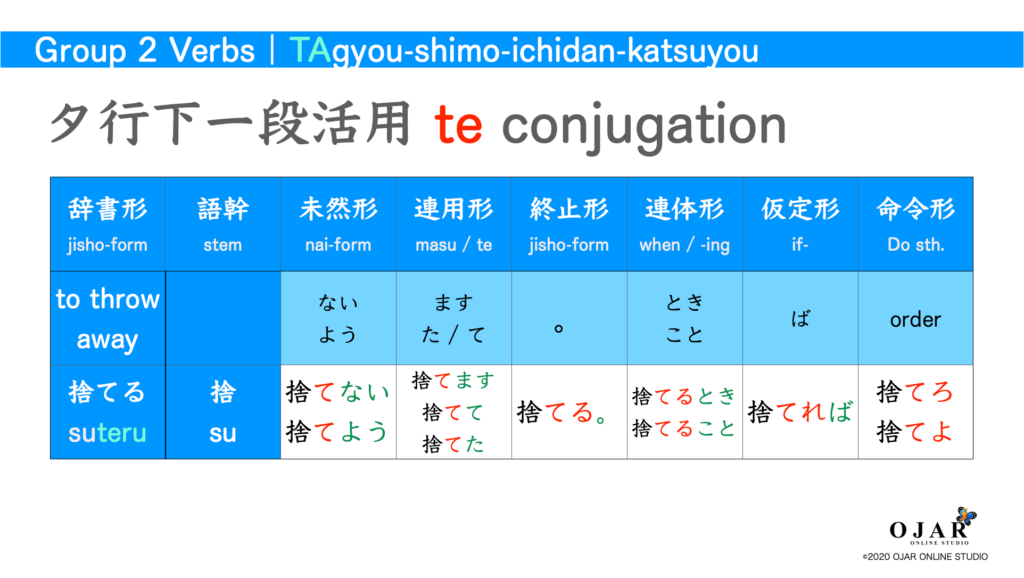
There are other verbs like this below.
| 辞書形 jisho-form | 未然形 nai-form | 連用形 masu-form / te-form | 終止形 jisho-form | 連体形 rentai-kei | 仮定形 katei-kei | 命令形 order-form |
|---|---|---|---|---|---|---|
| 奏でる kanaderu to play (music) | 奏でない 奏でよう | 奏でます 奏でた 奏でて | 奏でる。 | 奏でるとき 奏でること | 奏でれば | 奏でろ 奏でよ |
| 申し出る moushideru to offer | 申し出ない 申し出よう | 申し出ます 申し出た 申し出て | 申し出る。 | 申し出るとき 申し出ること | 申し出れば | 申し出ろ 申し出よ |
| 撫でる naderu to pat | 撫でない 撫でよう | 撫でます 撫でた 撫でて | 撫でる。 | 撫でるとき 撫でること | 撫でれば | 撫でろ 撫でよ |
・ナ行下一段活用 ne conjugation
“ナ行下一段活用 NAgyou-shimo-ichidan-katsuyou” always conjugates with ne of the suffix. Let’s think about “寝る neru to sleep”.
語幹:寝る
活用語尾:寝る
活用:ナ行下一段活用 NAgyou-shimo-ichidan-katsuyou
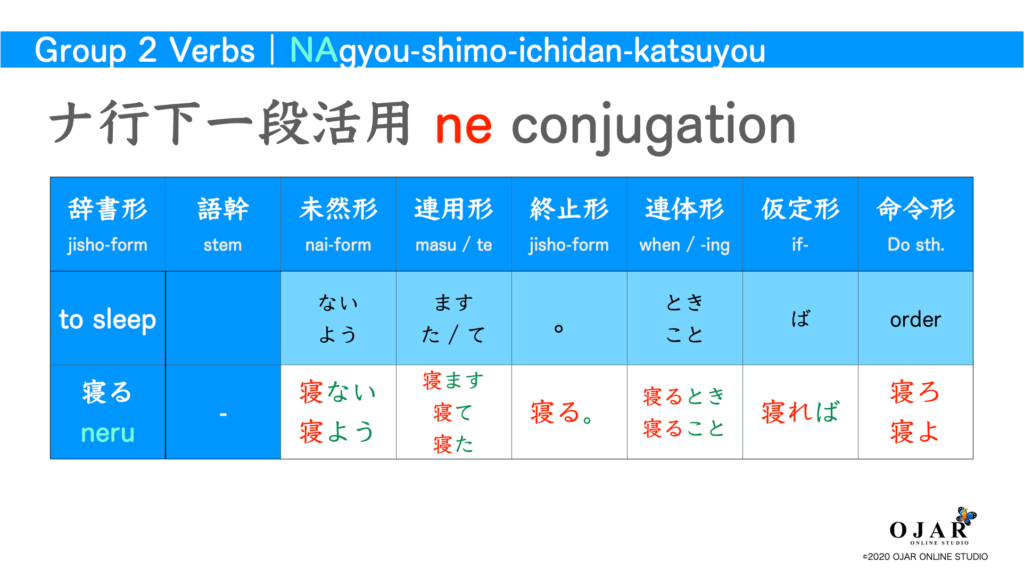
There are other verbs like this below.
| 辞書形 jisho-form | 未然形 nai-form | 連用形 masu-form / te-form | 終止形 jisho-form | 連体形 rentai-kei | 仮定形 katei-kei | 命令形 order-form |
|---|---|---|---|---|---|---|
| 尋ねる tazuneru to ask | 尋ねない 尋ねよう | 尋ねます 尋ねた 尋ねて | 尋ねる。 | 尋ねるとき 尋ねること | 尋ねれば | 尋ねろ 尋ねよ |
| 束ねる tabaneru to tie | 束ねない 束ねよう | 束ねます 束ねた 束ねて | 束ねる。 | 束ねるとき 束ねること | 束ねれば | 束ねろ 束ねよ |
| 跳ねる haneru to jump | 跳ねない 跳ねよう | 跳ねます 跳ねた 跳ねて | 跳ねる。 | 跳ねるとき 跳ねること | 跳ねれば | 跳ねろ 跳ねよ |
・バ行下一段活用 be conjugation
“バ行下一段活用 BAgyou-shimo-ichidan-katsuyou” always conjugates with be of the suffix. Let’s think about “比べる kuraberu to compare”.
語幹:比
活用語尾:べる
活用:バ行下一段活用 BAgyou-shimo-ichidan-katsuyou
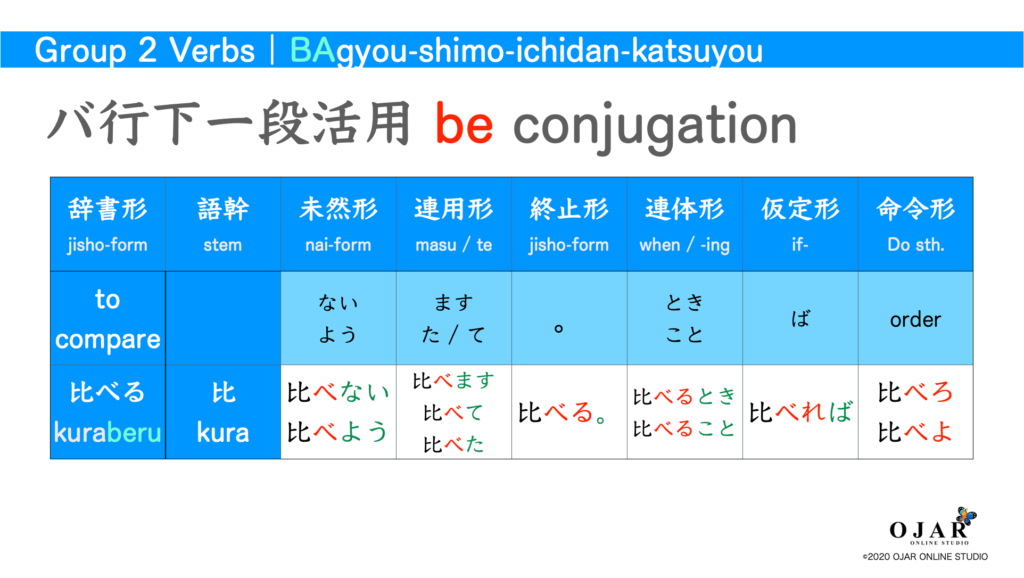
There are other verbs like this below.
| 辞書形 jisho-form | 未然形 nai-form | 連用形 masu-form / te-form | 終止形 jisho-form | 連体形 rentai-kei | 仮定形 katei-kei | 命令形 order-form |
|---|---|---|---|---|---|---|
| 並べる naraberu to arrange | 並べない 並べよう | 並べます 並べた 並べて | 並べる。 | 並べるとき 並べること | 並べれば | 並べろ 並べよ |
| 述べる noberu to describe | 述べない 述べよう | 述べます 述べた 述べて | 述べる。 | 述べるとき 述べること | 述べれば | 述べろ 述べよ |
・マ行下一段活用 me conjugation
“マ行下一段活用 MAgyou-shimo-ichidan-katsuyou” always conjugates with me of the suffix. Let’s think about “諦める akirameru to give up”.
語幹:諦
活用語尾:める
活用:マ行下一段活用 MAgyou-shimo-ichidan-katsuyou
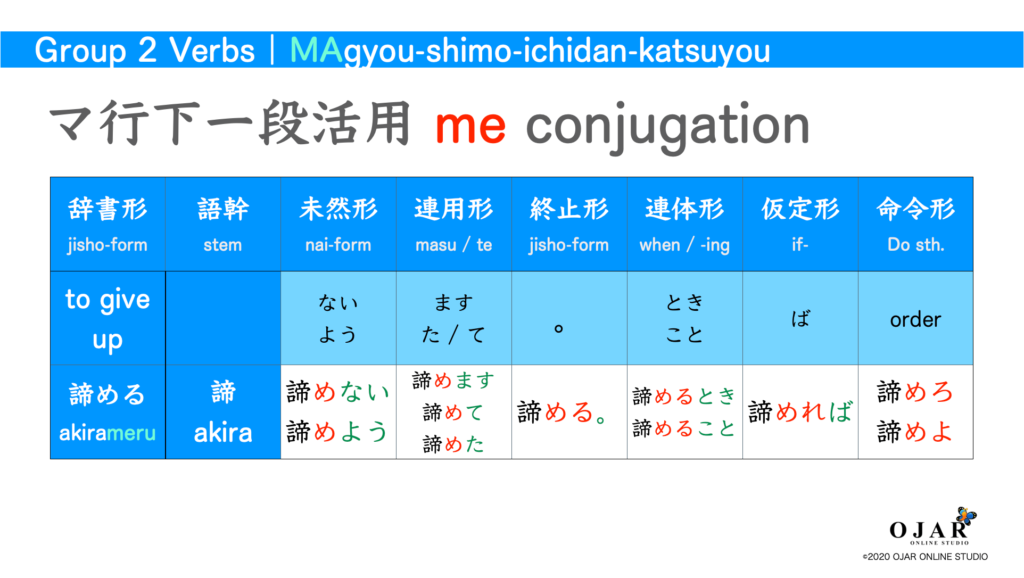
There are other verbs like this below.
| 辞書形 jisho-form | 未然形 nai-form | 連用形 masu-form / te-form | 終止形 jisho-form | 連体形 rentai-kei | 仮定形 katei-kei | 命令形 order-form |
|---|---|---|---|---|---|---|
| 止める tomeru to stop | 止めない 止めよう | 止めます 止めた 止めて | 止める。 | 止めるとき 止めること | 止めれば | 止めろ 止めよ |
| 勤める tsutomeru to work | 勤めない 勤めよう | 勤めます 勤めた 勤めて | 勤める。 | 勤めるとき 勤めること | 勤めれば | 勤めろ 勤めよ |
| 詰める tsumeru to pack | 詰めない 詰めよう | 詰めます 詰めた 詰めて | 詰める。 | 詰めるとき 詰めること | 詰めれば | 詰めろ 詰めよ |
・ラ行下一段活用 re conjugation
“ラ行下一段活用 RAgyou-shimo-ichidan-katsuyou” always conjugates with re of the suffix. Let’s think about “慣れる nareru to get used to”.
幹:慣
活用語尾:れる
活用:ラ行下一段活用 RAgyou-shimo-ichidan-katsuyou
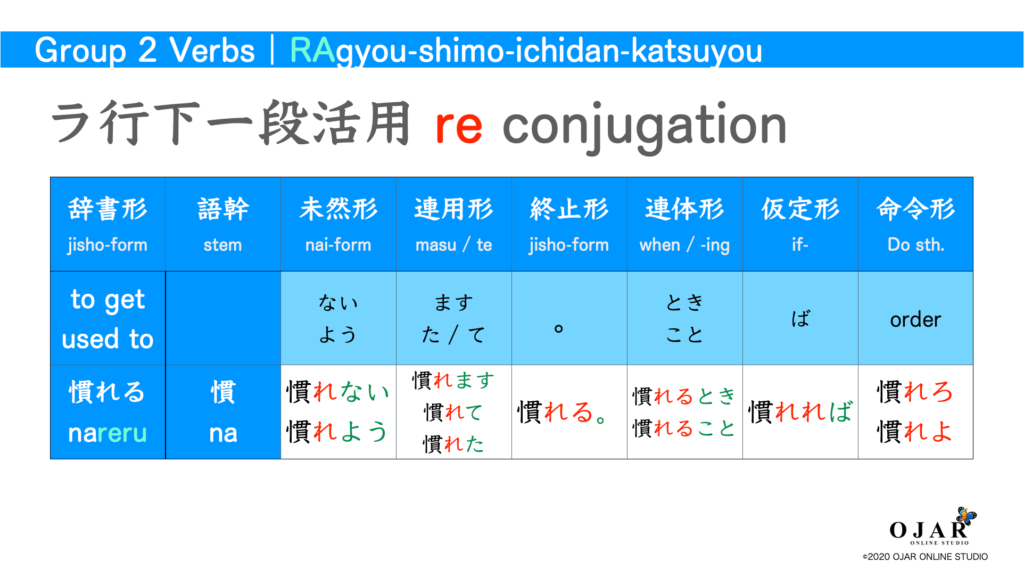
There are other verbs like this below.
| 辞書形 jisho-form | 未然形 nai-form | 連用形 masu-form / te-form | 終止形 jisho-form | 連体形 rentai-kei | 仮定形 katei-kei | 命令形order-form |
|---|---|---|---|---|---|---|
| 忘れる wasureru to forget | 忘れない 忘れよう | 忘れます 忘れた 忘れて | 忘れる。 | 忘れるとき 忘れること | 忘れれば | 忘れろ 忘れよ |
| 入れる ireru to put in | 入れな い 入れよう | 入れます 入れた 入れて | 入れる。 | 入れるとき 入れること | 入れれば | 入れろ 入れよ |
| 遅れる okureru to be late | 遅れない 遅れよう | 遅れます 遅れた 遅れて | 遅れる。 | 遅れるとき 遅れること | 遅れれば | 遅れろ 遅れよ |
Let’s Practice
Homework
Conjugate these verbs in Japanese to the comment below!
①落ちる
②別れる
③進める
Okay, that’s all for today!
Good luck with your Japanese study 😊
A Dictionary of Basic Japanese Grammar
| Amazon Reviews: | ★★★★★ |
|---|
Publisher: JAPAN TIMES
P.S. My English skill is not enough yet. Please correct me with DM from CONTACT if my English is wrong. Thank you for your cooperation!
Next Lesson is; CLICK HERE!
Japanese Lesson 18:Verb Conjugation Group 3
Previous Lesson is; CLICK HERE!
Japanese Lesson 16: Verb Conjugation Group 1

